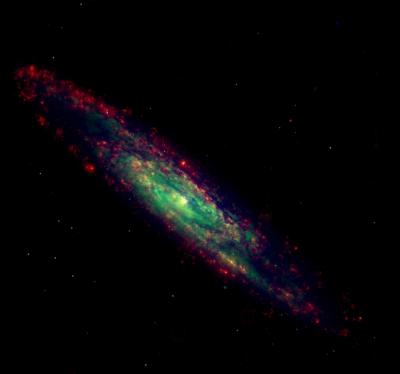How to feed a starburst
|
J. Ott (ATNF); C. Henkel (Max Planck Institut für Radioastronomie, Germany); A. Weiss (Institut de Radioastronomie Millimétrique; Spain); F. Walter (Max Planck Institut für Astronomie, Germany) A major challenge in observational and theoretical astrophysics is to understand the processes which lead to the formation of stars. In the cosmic cycle, interstellar gas condenses and cools down. If the gas is sufficiently cold and dense, the material cannot withstand the gravitational forces imposed by its own mass and eventually collapses. The gravitational collapse condenses the gas to the point where nuclear fusion sets in and a star is born. Once the fusion processes have used all the available fuel, the most massive stars will explode as supernovae, ejecting large amounts of debris, dust and gas, and the cycle starts all over again. The Milky Way forms about three stars equivalent in mass to our Sun every year, a value which is typical for "normal" spiral galaxies. A few galaxies can be found, however, where a similar or larger number of stars form within an area about five thousand times smaller than the body of the Milky Way. These galaxies are called "starburst galaxies" and the starburst region is usually located at their very centres, from which spectacular outflows of hot gas are observed. The outflows are driven by the combined effect of stellar winds and multiple supernova explosions within this very small area. The Australia Telescope Compact Array is being used to study in detail how the gas is fed into the starburst region and, in turn, what influence the starburst has on its own supply. During the initial cooling process the gaseous fuel forms molecules. Their formation and destruction rate, as well as their excitation state, depend on the conditions which prevail in the vicinity of the starburst. Many molecules are accessible in the millimetre regime of the electromagnetic spectrum - a window which was recently opened at the Compact Array with the 12- and 3- mm upgrades. One of the most prominent and nearby starburst galaxies is NGC 253, at a distance of 2.6 million parsecs. An image of NGC 253 is shown in Figure 1. First results of the temperature distribution (obtained from multiple transitions of the ammonia molecule in the 12-mm band) within the molecular gas in the nucleus of NGC 253 were shown in the ATNF Annual Report 2003. This report shows more recent 3-mm observations of the (1-0) transitions of the HCN and HNC molecules. In NGC 253, the interstellar gas is transported toward the galaxy's nucleus along a prominent bar (see Figures 1 and 2). In the process, the gas density increases and eventually forms molecules. The star formation sites are within the very dense molecular gas component (density >104 cm-3, e.g., Gao & Solomon 2004), which is compacted by the streaming motion. This peculiar gas phase is traced by rotational transitions of molecules with a large electric dipole moment, such as ammonia, HCN, and HNC. The details of the chemical network are rather complex, but since HCN and HNC consist of the same atoms and have a very similar structure, they should be catalysed in similar quantities (see Schilke et al. 1992; Aalto et al. 2002). At high densities and temperatures, however, HNC is converted into HCN via the reaction: HNC + H → HCN + H, and high HCN/HNC ratios of order 10 are observed in "normal" non-starbursting galaxies. In contrast, the Compact Array observations of NGC 253 show that the HCN/HNC ratio decreases close to the starburst centre (Figure 2). Indeed, the ammonia observations have shown that the dense gas is cooler at the very centre of the starburst as compared to molecular gas further away. At first glance, this is counter-intuitive as it is the centre where most of the violent star formation takes place. However, this may be explained by the fact that only very cold gas can turn into stars and therefore sustain the purgatory-like conditions in these fascinating galaxies. In addition, close to the starburst centre, within the diffuse molecular gas, the atomic hydrogen is likely to be ionised (see the H image in Figure 2). In the very dense gas, which is self-shielded against the ionising radiation of the starburst, most of the hydrogen is transformed into molecular hydrogen H2 . In summary, the lower abundance of atomic hydrogen plus the cooler temperatures within the molecular clumps at the very starburst centre decrease the HNC + H → HCN + H reaction rate. This may be one of the reasons why we observe a lower HCN/HNC ratio at the very centre of NGC 253. A second factor for low HCN/HNC ratios at the centre of the starburst is likely to be the reactions HCNH+ + e- → HCN + H, and HCNH+ + e- → HNC + H, which produce HCN and HNC in equal quantities (see above; see also Schilke et al. 1992; Aalto et al. 2002; Meier & Turner 2005). This reaction is enhanced by the high fraction of ions close to the starburst core. Over the coming months HCN and HNC observations of a larger sample of starburst galaxies will be obtained. The galaxies are selected to have different current star formation rates and some of them also harbour active galactic nuclei, massive black holes that produce extremely collimated and extended jets of relativistic plasma. Together with the Compact Array observations of the ammonia molecule, the HCN and HNC observations will help to determine the physical and chemical state of the dense molecular material in great detail, being able to trace the effects a starburst and an active galactic nucleus have on its own fuel. Virtually all galaxies that are currently detected at high redshift, i.e., in the early Universe, show evidence of tremendous nuclear or circumnuclear starbursts. The understanding of nearby examples will therefore help us to unravel the star formation processes at any cosmic epoch.
References: |
|


